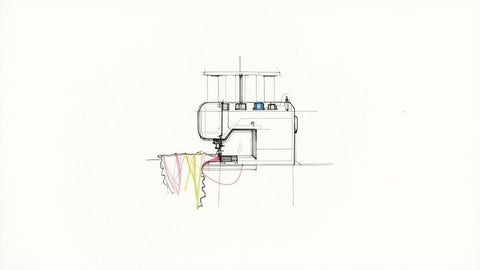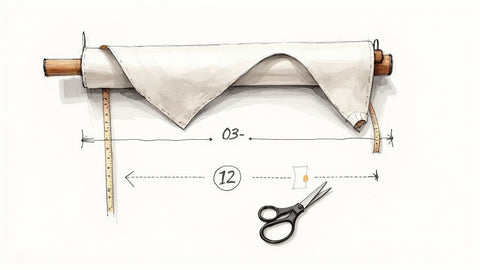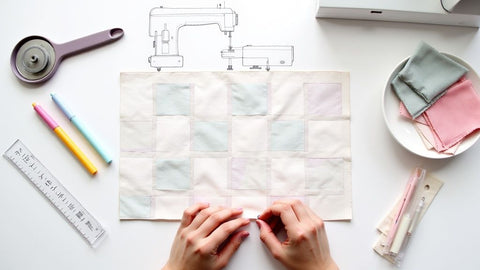If you've ever glanced inside a store-bought T-shirt and wondered how they create those perfect, stretchable seams, you've seen the handiwork of a serger. Often called an overlock machine, a serger is a special type of sewing machine with a very specific, and very powerful, job.
In one single pass, it stitches a seam, trims the excess fabric, and encases the raw edge in a thread casing. It’s the secret weapon for taking your projects from looking "homemade" to beautifully handmade. At bsewinn.com, our goal is to empower crafters like you with the tools and knowledge to create tangible, replicable projects, and a serger is a key part of that journey.
What a Serger Machine Does
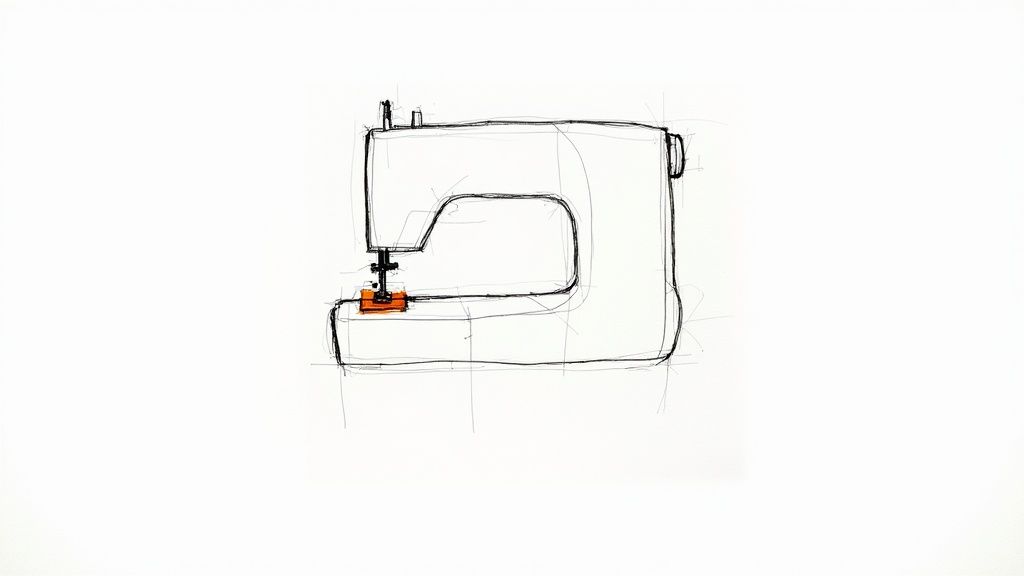
So, what’s happening under the hood? Your standard sewing machine uses a single needle thread and a bobbin to form a lockstitch, which is strong but has very little give. A serger, on the other hand, doesn't even use a bobbin. Instead, it uses multiple threads—usually three or four—that are fed through a complex system of "loopers."
These loopers work in a coordinated dance, wrapping the threads around the fabric's edge to create a flexible, chain-like stitch. As this is happening, a small, razor-sharp blade neatly trims the raw edge of the fabric just before the needles stitch. It’s this simultaneous trim-and-stitch action that makes a serger an absolute powerhouse for efficiency and a flawless finish.
Core Serger Functions
At its heart, a serger is built to do three things at once, which is precisely why it’s such a game-changer for anyone who sews regularly.
- Stitching: It creates a seam that can stretch and move, making it perfect for joining knit fabrics like jersey or spandex.
- Trimming: The built-in knife slices away the excess seam allowance as you sew, giving you a perfectly uniform edge every time. No more wobbly cutting!
- Overcasting: As it stitches, it wraps the newly trimmed edge in thread, completely preventing it from fraying and giving the inside of your garment that clean, ready-to-wear look.
To put it simply, here’s a quick breakdown of what a serger accomplishes in a single pass.
Serger Functions at a Glance
| Function | Description | Primary Benefit |
|---|---|---|
| Seaming | Joins two pieces of fabric with an interlocking thread chain. | Creates strong, flexible seams ideal for knit and woven fabrics. |
| Trimming | A built-in blade cuts the raw fabric edge just before stitching. | Guarantees a clean, perfectly even seam allowance. |
| Overcasting | Wraps the trimmed edge of the fabric with thread loops. | Prevents fraying and provides a durable, professional finish. |
This all-in-one process is what makes the serger an indispensable tool for achieving professional-quality results quickly and reliably.
At bsewinn.com, we are committed to empowering crafters with the right equipment to completely transform their creative process. A serger is one of those tools that truly elevates your craft.
A serger doesn't just finish an edge; it secures it with a flexible, durable stitch that moves with the fabric. This is why it is the go-to machine for everything from activewear to delicate rolled hems on scarves.
For anyone curious about what modern sergers can do, models like the Baby Lock Acclaim Serger with RevolutionAir™ Threading are a great example of how technology has made these machines incredibly user-friendly. Paired with our supportive online classes, training, and extensive resources, we're here to help you master any machine and create designs you’re proud of.
Serger vs. Sewing Machine: What's the Real Difference?
It’s a common question in the crafting world: is a serger just a fancier, more complicated sewing machine? While both machines join fabric with thread, thinking of them as interchangeable is a big mistake. They're actually partners, each with a very different, very specific job in your sewing room.
Think of your standard sewing machine as your project's general contractor. It’s the versatile workhorse you rely on for all the core construction tasks—setting zippers, making buttonholes, topstitching, and piecing quilts. It's the essential tool for building your project from the ground up.
A serger, on the other hand, is a high-speed finishing specialist. Its main purpose is to create strong, flexible seams while simultaneously trimming the raw fabric edge and wrapping it in thread. This all-in-one action is what makes a serger so unique and something a regular sewing machine just can't replicate.
How They Work Differently
The real magic is in the mechanics. Your sewing machine creates a lockstitch using a single needle thread that interlocks with a thread from a bobbin below. It’s simple and strong.
A serger doesn't have a bobbin at all. Instead, it uses multiple threads—usually between three and five—that are fed into a complex system of loopers. These loopers create a chain of interconnected stitches that wrap around the seam's edge.
Even more importantly, a serger has a built-in blade that slices off the excess seam allowance just moments before the needles stitch. This creates that perfectly neat, professional-looking finish you see on store-bought clothes, and it completely stops the fabric from fraying.
A standard sewing machine joins fabric from the middle. A serger builds a seam from the edge inward, creating a secure, flexible, and perfectly finished boundary in one swift motion.
At bsewinn.com, we help crafters see that these machines aren't rivals; they’re a team. Our commitment is to empower you through our custom sewing machine designs and the training to master both, ensuring you have the right tool for every step of your project.
When to Use a Serger
So, when should you fire up the serger instead of your trusty sewing machine? It all comes down to the fabric you're using and the type of finish you need.
A serger is an absolute game-changer for working with knit fabrics. Its naturally stretchy seam moves and flexes with materials like jersey, spandex, and fleece, which means no more popped threads when you pull on a t-shirt or a pair of leggings. It's the secret to professional-looking activewear and casual knit garments.
This incredible technology has been around for a while. The first overlock machines appeared in the late 19th century when Joseph M. Merrow patented a device that could both crochet and overlock, a pivotal moment for industrial garment manufacturing. You can dive deeper into the history of sewing machines to see how these innovations evolved side-by-side.
Comparing Sergers and Standard Sewing Machines
To really see where each machine shines, let's put them head-to-head.
| Feature | Serger Machine | Standard Sewing Machine |
|---|---|---|
| Primary Function | Seam finishing, edge trimming, and stretch seams | Construction, topstitching, buttonholes, zippers |
| Stitch Type | Overlock stitch (created by loopers) | Lockstitch (created by needle and bobbin) |
| Number of Threads | 3 to 5 | 1 to 2 (including bobbin) |
| Fabric Handling | Excellent for knits, stretch fabrics, and sheer fabrics | Versatile for wovens; can struggle with very stretchy knits |
| Built-in Blade | Yes, trims fabric as it sews | No |
| Speed | Very fast (up to 1,700 stitches per minute) | Slower, more controlled speed |
| Best For | T-shirts, leggings, swimwear, finishing seams, rolled hems | Quilting, garment construction, zippers, decorative stitches |
This table makes it clear: you don't choose one over the other. You choose the right one for the job at hand.
This quick visual shows two common thread setups on a serger, highlighting how different configurations achieve different results.
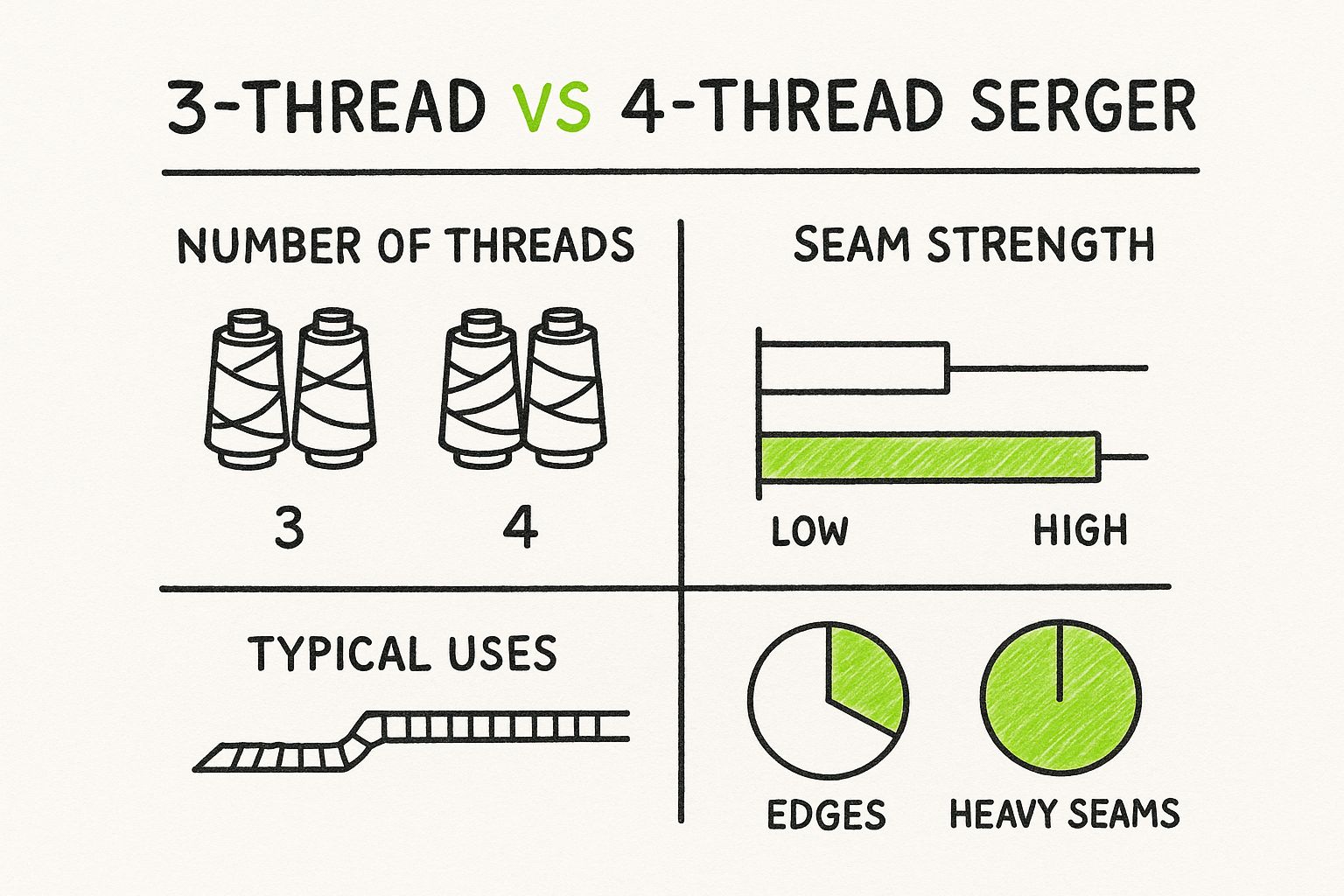
As you can see, a 4-thread overlock creates a strong, durable construction seam, while a 3-thread setup is perfect for simply finishing an edge to prevent fraying. By understanding their distinct strengths, you can build a powerful sewing toolkit that lets you bring any creative vision to life.
Understanding the Anatomy of a Serger
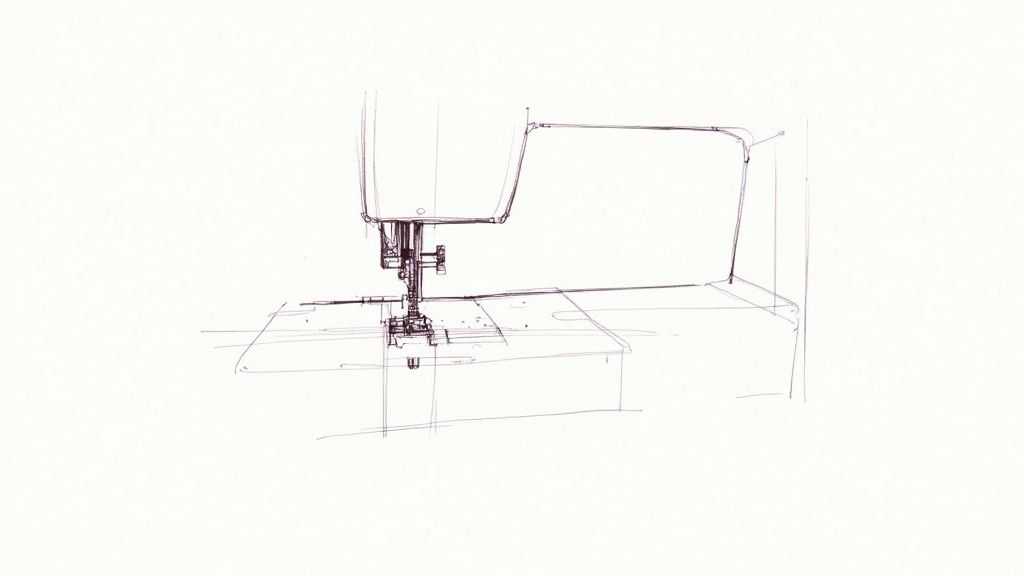
Popping the cover off a serger can feel a bit like looking under the hood of a race car—it's a lot of moving parts. But once you know what you're looking at, it all starts to make sense. Getting familiar with the key players inside your machine is the first step toward feeling confident and in control.
At the very heart of the serger are the loopers. A regular sewing machine has a simple bobbin, but a serger has an upper and lower looper that work together in a beautifully synchronized dance. These metal arms weave threads over and under the fabric, creating that classic overlock stitch that wraps around the edge of the seam. This is what gives serged seams their incredible strength and stretch.
Right next to the loopers, you'll find the cutting blades. A serger has two of them, an upper and a lower, that work just like a pair of scissors. They slice off the raw edge of the fabric a split second before the needles stitch, leaving you with a perfectly clean and even seam allowance. This single action is one of the biggest things that sets a serger apart.
Key Components That Control Your Stitches
Beyond those core parts, a few other components give you the fine-tuned control you need for professional-looking projects.
- Upper and Lower Loopers: These are the real workhorses, creating the chain of thread that encases the fabric edge.
- Needles: Sergers use either one or two needles that work in tandem with the loopers to form the seam. The number of needles you use will change the type of stitch you get, like a 3-thread or 4-thread overlock.
- Cutting Blades: This two-blade system is your secret to a clean, no-fray finish. You can also disengage the upper blade when you don’t want to trim the fabric.
Let's be honest—threading all these parts, especially the loopers, can be intimidating. It's the one thing that gives new serger owners the most anxiety. The good news is that modern machines have come a long way in making this easier. If you're just starting, our comprehensive guide on how to thread a serger breaks it down into simple, clear steps to get you up and running fast.
The Power of Differential Feed
If there’s one feature you absolutely need to understand, it’s the differential feed. This is the serger’s secret weapon. The system uses two sets of feed dogs—those little metal teeth under the needle that pull your fabric through—which can move at different speeds.
By adjusting the differential feed, you can either gently stretch the fabric as you sew or slightly gather it. This is a game-changer. It stops stretchy knit fabrics from getting wavy and prevents thin, silky fabrics from puckering, so your seams always lie perfectly flat.
This is what gives you total command over how your fabric behaves. Here at bsewinn.com, we believe that really understanding how your machine works is what unlocks its creative potential. Through our extensive resources and training, we help you move from just using a tool to truly mastering it.
What Can a Serger Do That My Sewing Machine Can't?
Thinking about adding a serger to your sewing room? It's a big step, but the payoff is huge and almost immediate. Once you see what a serger does best, you'll understand why so many sewists consider it an essential tool. The benefits really boil down to three game-changers: sheer speed, incredibly durable seams, and that polished, professional finish.
The first thing you'll notice is just how fast these machines are. Your standard sewing machine might chug along at a few hundred stitches per minute. A serger absolutely flies, easily hitting speeds of over 1,000 stitches per minute. For you, that means you can whip up a tangible project like a knit t-shirt or finish the seams on a pair of jeans in a tiny fraction of the time. It completely changes your workflow.
Built-to-Last Seams for Modern Fabrics
Speed is great, but the durability a serger offers is where it truly shines, especially with all the knit and stretch fabrics we love to use today. A regular sewing machine creates a lockstitch, which is strong but has very little give. The second you stretch that fabric, you risk hearing that dreaded pop as the thread breaks.
A serger's overlock stitch is a whole different animal. It's constructed with interlocking loops of thread that create a seam with built-in stretch. It moves with the fabric instead of fighting against it. This makes it the go-to choice for creating clothes that can handle real life, like:
- Activewear: Think leggings and workout tops that need to stretch in every direction without failing.
- Children’s Clothing: These garments get put through the wringer with constant play and washing.
- Casual Knits: Your favorite t-shirts and sweaters will have seams that hold up, wear after wear.
Get That Professional, Store-Bought Look
Finally, a serger is the secret to getting that clean, tidy finish you see on clothes in a retail store. It trims the raw fabric edge and wraps it in thread all in one go, completely preventing any fraying. This doesn't just look better—it makes the whole garment last longer.
A serger is what takes the inside of your garment from looking "homemade" to looking "professionally made." It’s that one detail that elevates your work and gives you the confidence to create pieces that truly look and feel high-end.
This ability to finish seams quickly and cleanly is exactly why sergers are the workhorses of the fashion industry. Industrial sergers, which can use anywhere from two to five threads and hit speeds up to 1,500 stitches per minute, are the backbone of modern garment manufacturing. Their dominance in an industry that produces millions of garments a day tells you everything you need to know about their efficiency. You can learn more about how we got here in the complete history of the sewing machine.
Here at bsewinn.com, we want to give you the tools and skills to make things you're truly proud of. By offering a curated selection of sergers and the supportive online training to go with them, we’re here to help you bring that professional quality right into your own sewing space.
When to Use Your Serger for the Best Results
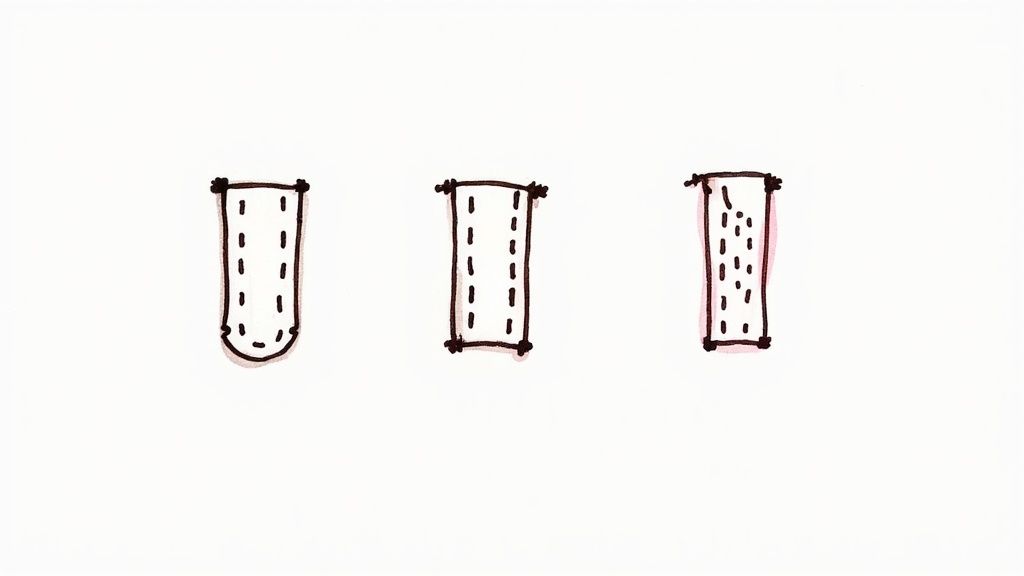
Knowing what a serger is and understanding its parts is a great start. But the real magic happens when you know exactly when to use it. Let's move from theory to practice with some tangible examples of projects where a serger isn't just helpful—it’s the absolute best tool for the job.
Think of it this way: your sewing machine is your trusty all-rounder, your jack-of-all-trades. The serger, on the other hand, is your specialist. It’s the expert you call in for speed, stretch, and a flawless finish, especially on tricky fabrics. Choosing the right tool makes all the difference, turning a frustrating task into a smooth, rewarding process.
Constructing with Knit Fabrics
If you plan on sewing with knits or any kind of stretch material, a serger is about to become your best friend. Seriously. For projects like t-shirts, leggings, swimwear, and activewear that crafters can replicate, a serger is practically built for the task.
The overlock stitch it creates is inherently stretchy, so it moves and recovers right along with the fabric. This completely prevents that dreaded "pop!" of a broken seam when you stretch your garment—a common headache when using a rigid lockstitch from a regular sewing machine. You can build an entire knit garment from start to finish on a serger, and the seams will be both strong and flexible.
The differential feed on a serger is the game-changer for knits. It stops the fabric from stretching out as you sew, so you can say goodbye to those wavy, rippled seams that often plague knit projects sewn on a standard machine.
Flawlessly Finishing Woven Fabrics
While knits might be a serger’s main claim to fame, it's also a powerhouse for finishing seams on woven fabrics like cotton, linen, or denim. We all know how badly those raw edges can fray, especially after a few trips through the laundry. Over time, that fraying can weaken the whole garment.
A serger solves this problem in one quick pass. It trims the raw edge and neatly wraps it in thread, stopping frays before they can even start. This is so much faster and more durable than using pinking shears or a zigzag stitch. Finishing your internal seams this way gives your handmade clothes a clean, professional look that helps them last for years.
A great tangible example that showcases this is the Cutting-Edge Clutch Bag Serger Project. This how-to guide lets crafters replicate a stunning design while seeing firsthand how a serger gives woven materials a beautiful, durable finish.
Creating Delicate Rolled Hems
A serger also shines when it comes to creating beautiful, delicate finishes that are a real pain to do by hand or on a standard machine. The rolled hem is the perfect example.
By making a few simple adjustments to the stitch settings, a serger can tightly wrap thread around the very edge of a lightweight fabric. The result is a tiny, cord-like hem that looks incredibly high-end. This technique is ideal for tangible projects crafters can create, such as:
- Scarves: It gives a professional, airy finish to silk or chiffon.
- Formalwear: It's perfect for hemming evening gowns and delicate blouses.
- Linens: It creates elegant napkins and tablecloths with a decorative edge.
At bsewinn.com, our commitment is to empower crafters by providing not just custom sewing machines, but also the skills to master them. Our supportive online classes serve as comprehensive how-to guides, walking you through these exact applications and giving you the confidence to turn ambitious ideas into beautifully finished projects you can be proud of.
Your Top Serger Questions, Answered
Jumping into the world of sergers is exciting, but let's be honest—it can also feel a little intimidating. You've got this powerful machine, but what does it really do? I've heard all the questions over the years, so let's clear up the confusion and get you sewing with total confidence.
Think of it this way: your serger isn't here to replace your trusty sewing machine. It's the specialist you bring in to take your projects to the next level.
Can a Serger Completely Replace My Sewing Machine?
In a word, no. A serger is a fantastic partner to your sewing machine, but it can't fly solo. It’s a master at what it does—finishing edges and seaming knits at lightning speed—but it simply can't handle many of the bread-and-butter tasks of sewing.
You'll still need your regular machine for essentials like putting in zippers, making buttonholes, topstitching, and even just sewing in reverse. They're a team. Your sewing machine builds the foundation, and your serger gives it that professional, durable finish.
Is Threading a Serger Really That Difficult?
Ah, the age-old question! The sight of all those threads and loopers can definitely look like a tangled mess at first. But I promise, it's more bark than bite, especially with today's machines.
Modern sergers are designed to help you out. Most have color-coded threading paths, easy-to-follow diagrams printed right on the machine, and some higher-end models even feature incredible air-threading technology that does most of the work for you.
It looks complicated, I get it. But threading a serger is just a skill you learn, like tying your shoes. After a few practice runs, you'll be able to do it in minutes without even thinking about it.
At bsewinn.com, we know this is a big hurdle for new owners. That's why we are committed to empowering you with support through step-by-step video guides and extensive online resources for the models we carry. We want to help you turn that initial fear into a quick, routine part of your sewing process.
What Is Differential Feed and Why Do I Need It?
Okay, this is one of those features that sounds technical but is actually a total game-changer. A serger with differential feed has two sets of feed dogs (the little teeth that pull your fabric through). You can control the speed of each set independently.
Why does that matter? It gives you incredible control. If you're sewing a stretchy knit fabric that tends to get wavy, you can adjust the feed dogs to prevent that stretching, leaving you with a perfectly flat, beautiful seam. You can even use it in the other direction to create a gentle gather or a beautiful "lettuce-edge" hem. Getting the hang of differential feed is the secret to flawless seams.
What Kind of Thread Should I Use for My Serger?
Sergers are thirsty. Because they use 3 or 4 threads at once and stitch so incredibly fast, they go through a lot of thread. This is why you almost always see serger thread sold on large cones—it's the most practical and budget-friendly way to go.
This type of thread is usually a smooth, lightweight polyester that’s strong enough to handle high speeds without snapping or leaving a mess of lint behind.
Could you use your regular spools of sewing thread? Technically, yes, but you'd be changing them constantly, probably right in the middle of a long seam. Trust me, investing in a few basic cones of serger thread will make your life so much easier and your sewing far more enjoyable.
Here at B-Sew Inn, our commitment is to empower every crafter. We provide more than just the best tools; we give you the skills to master them. From our custom sewing machine designs to our comprehensive online classes and extensive training resources, we are here to support you in elevating your projects from homemade to professionally handmade. Visit us at https://www.bsewinn.com and let's start your creative journey.

